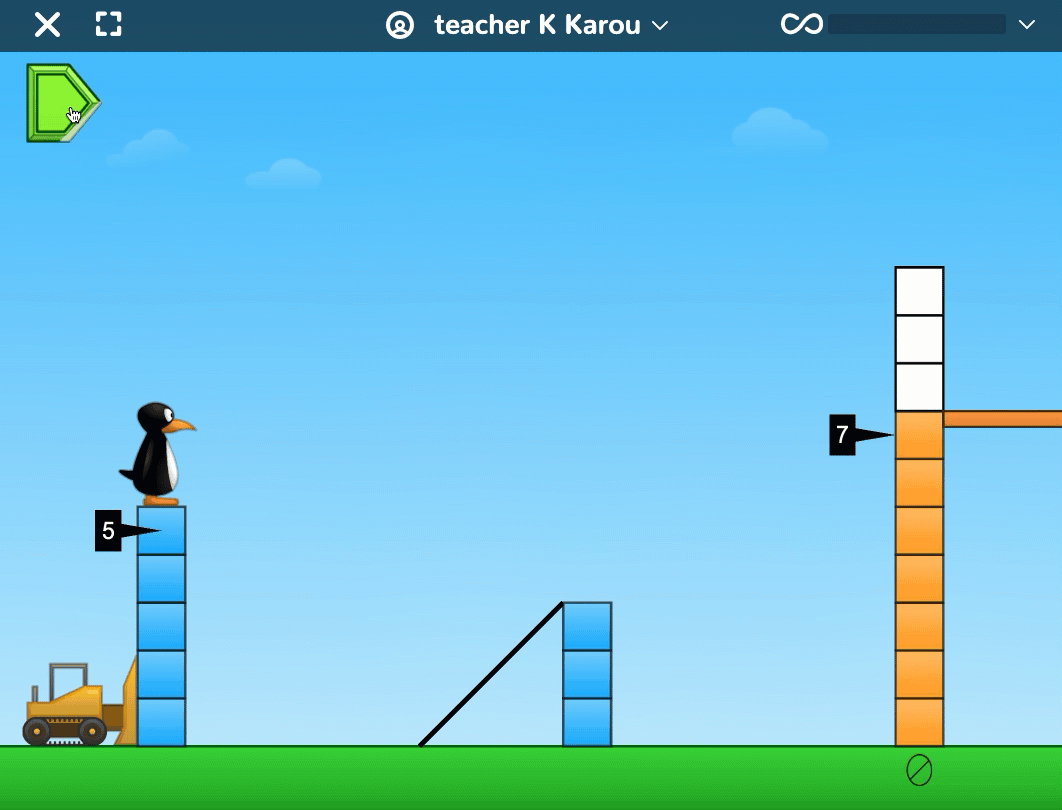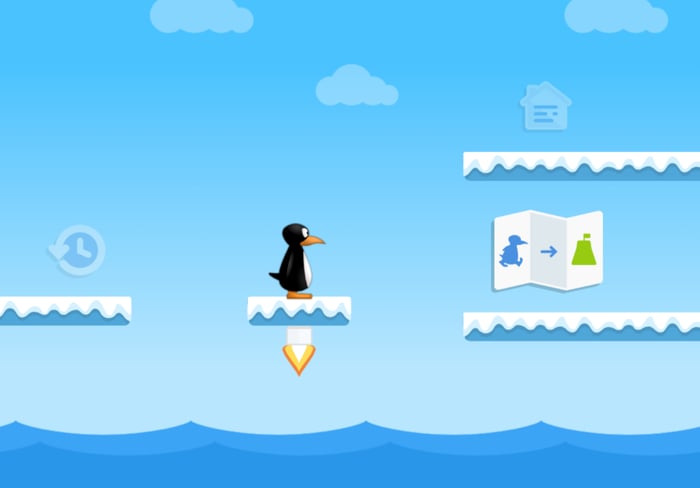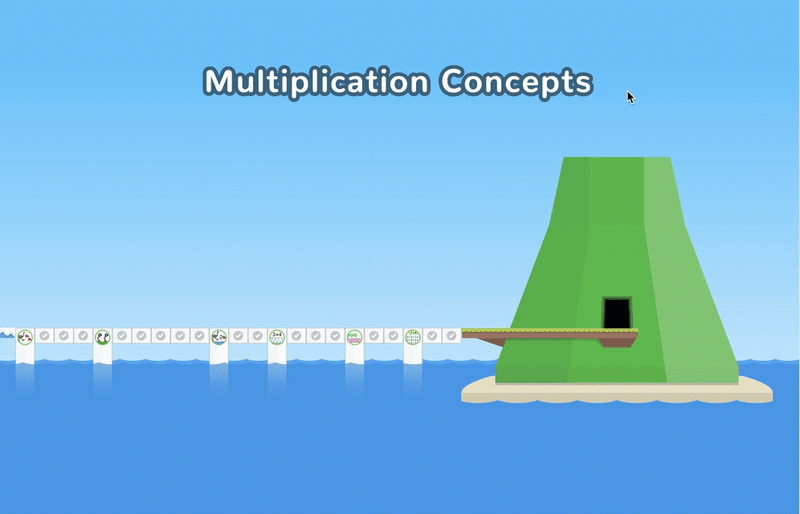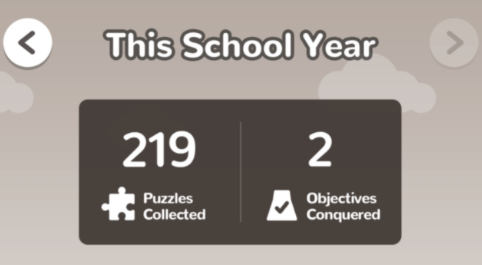
The statement above made 20 years ago would have been met with a lot of skepticism. Now, with over 20 years of history, millions of students across the country are learning problem-driven mathematics in the ST Math program. With the release of the 6th version, the new ST Math has doubled down on its learning science roots to create deeper levels of learning.
Below are some of the key highlights for how we make this learning happen...
 Figure 1. The game Leg Drape shown with the addition of the Go Button, hint functionality, and keyboard controls
Figure 1. The game Leg Drape shown with the addition of the Go Button, hint functionality, and keyboard controls
At the heart of ST Math is the patented spatial-temporal puzzles. While maintaining the zen-like nature of ST Math, there have been a number of enhancements to individual games. Hint functionality allows students and teachers to more precisely see which elements on the screen are interactive. Enhanced animations make the animation sequence easier to follow. All games in the new ST Math support keyboard control, allowing students to use the keyboard in order to play them.
In order to provide an additional opportunity for students to “Think Before They Click,” a Go Button has been added to each game to ensure students have a second chance before they make their final answer. All of these elements are enhancements designed around the spatial-temporal game play that is at the core of ST Math.
The center of learning in ST Math lies in the informative feedback. Based on engaging students in the perception-action cycle, this unique approach of displaying visual animations in response to student input is what marks ST Math as one of the pioneers in its field.

Figure 2. Using the animation controls to control the animation in the game ‘Push Box’
To build games for the new ST Math, we used a novel development process that puts the animations on a timeline, as opposed to a more traditional approach of implementing animation through code sentences. This feat of engineering allowed us to add animation controls which gives students direct control over the informative feedback animation.
Since the feedback acts as a visual proof of the mathematics, this turns every game into a visual, mathematics proof simulation of sorts, allowing every student real-time access to this tool. In addition to student use, this feature can be especially powerful for teachers facilitating a student, by allowing them to pause, rewind, and focus on a specific point of the animation to discuss the key mathematics idea. This feature enables a deeper level of interaction with the feedback in ST Math.
One of the beautiful aspects of ST Math is how the puzzles allow for a range of strategies to be used while solving them. While the animated feedback does encourage a strategy, the nature of the visual model allows students to flexibly think about the mathematics and have the freedom to derive and test their own strategies, much like a scientist performing a science experiment.
However, since most of this thinking is done in the student’s mind, the variety of approaches to solving a puzzle are typically invisible to teachers.

Figure 3. In the 3rd grade multiplication and division game Fruit Monster, the annotation tool is used to show three different strategies that may be used to solve the problem.
The new annotation tool allows students to record their thinking on the screen, bringing students’ strategies to the forefront. This can be used by a student individually, students sharing strategies with each other, or teachers using the tool as a method to discuss the strategy taken by a student.
Since ST Math enables multiple strategies for solving its puzzles, this affords teachers the opportunity to present and discuss multiple strategies used by students, as shown above. This can lend itself well while discussing a puzzle with the class, extending the schemas students have built in ST Math and allowing ST Math to be the foundation for strategy development.
 Figure 4. Student home screen in the new ST Math
Figure 4. Student home screen in the new ST Math
One of the most powerful elements of ST Math is the way it captures deep student engagement. Much of this is the result of ST Math’s application of game-based learning principles to the student learning experience. From puzzle driven scenarios to traversing through Learning Objectives, ST Math embodies what it truly means to be a game-based learning experience.
The new ST Math takes this experience even deeper.
 Figure 5: Visual of a Learning Objective in ST Math shown as a bridge with pillars and boxes for students to play through
Figure 5: Visual of a Learning Objective in ST Math shown as a bridge with pillars and boxes for students to play through
One of the most impactful aspects of game-based learning is the role of story. Rather than present learning scenarios in the abstract, stories provide a narrative students can connect with. Simply adding a character can create this effect, but even better when all the elements weave through the story context.
In the new ST Math, JiJi starts the Journey in the arctic and travels from island to island. Each Learning Objective, embodied as an island, has a spatial-temporal representation of the sequence of levels required to get to the end of the bridge. Along the bridge are visualizations of the essential learning elements: each pillar represents a game, and each block represents a level in that game.
This stays true to ST Math’s principle of only showing the essential elements of the learning experience and avoiding adding items that add additional cognitive load.
Student agency has become a huge focus in recent years. However, finding opportunities that enable this while maintaining meaningful learning is not always the easiest to design. In the new ST Math, in addition to the annotation tools and animation controls, we’ve created additional opportunities to put more agency in the hands of the students.
 Figure 6. Student data log showing this weeks and last weeks time and puzzle data, as well as the cumulative numbers shown in the student history
Figure 6. Student data log showing this weeks and last weeks time and puzzle data, as well as the cumulative numbers shown in the student history
One unique element of increasing student agency is allowing students to set and work toward their own goals. Students now have enhanced data views of the number of puzzles and minutes they have achieved per week, on average, and total.
This provides the opportunity for students to set goals based on their previous performance, and reflect and revise those goals as they progress. For example, students may set weekly goals on the way to yearly goals, which gives them more power to adjust their effort because they can measure progress toward those goals at every session.
The above are just a subset of the many elements designed to enhance and deepen learning in the new ST Math. For additional information, take a look at the other features or experience the games on the ST Math play page yourself!

Ki Karou is a seasoned expert in game-based learning and visual learning, with a focus on helping learners build mental schema and problem-solve. As the Senior Director of Product at MIND Education, Ki has led a team of learning and game designers, artists, and mathematicians in developing neuroscience-driven ed tech solutions for over a decade. A sought-after speaker and published author, Ki has shared his expertise at events like SXSW EDU and contributed articles to publications including the Huffington Post.
Comment